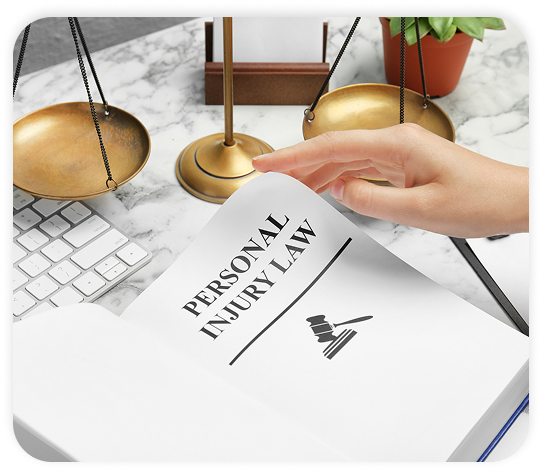Insurance Claims & Litigation in Ohio
How we negotiate with insurers, protect your rights, and – when needed – take your case to court.
After a crash or injury in Ohio, your path to compensation almost always runs through an insurance claim first. If the insurer won’t deal fairly, we pivot to litigation—filing a lawsuit in the proper Ohio court and preparing for trial. Below is exactly how our firm approaches both, what Ohio law says about claims, deadlines, damages, and common insurer tactics, and when we recommend filing suit.
We’ll review liability, coverages, and next steps in plain English.
Step 1: Claim setup & coverage map
- What we do in the first 7–10 days
- 1. Preserve evidence (scene photos, vehicle data, 911 audio, cameras, event data recorders, black-box downloads).
- 2. Open claims with all carriers that may apply:
- At-fault driver’s bodily injury liability (BI)
- Your medical payments (MedPay) (optional in Ohio)
- Your uninsured/underinsured motorist (UM/UIM) if the at-fault driver has no or too little insurance (Ohio UM/UIM is governed by R.C. 3937.18).
We’ll map every coverage that could pay for your losses – free.
Step 2: Ohio deadlines you must hit
- Personal injury statute of limitations:
- 2 years from the injury date to file suit (R.C. 2305.10). There are exceptions for minors and certain product-related injuries, but don’t bank on them.
- Claims against the State of Ohio (e.g., ODOT vehicle, state-operated bus):
- these are typically filed in the Ohio Court of Claims under R.C. Chapter 2743. Timing and notice rules differ from ordinary cases.
- Cities/townships/school districts:
- special immunity and procedures apply under Ohio’s Political Subdivision Tort Immunity Act (R.C. Chapter 2744).
- Not sure which deadline applies? We’ll confirm it for you today and send a written timeline.
Step 3: Proving fault under Ohio law
- Ohio uses modified comparative negligence. You can recover damages unless you are more than 50% at fault; if you are 50% or less at fault, your award is reduced by your share (R.C. 2315.33).
- How we prove negligence
- Scene investigation, downloads, and expert reconstruction
- Witness and first-responder interviews
- Medical causation reports linking injuries to the crash
- Company-policy and hours-of-service violations (for commercial defendants)
Step 4: Calculating damages (and what Ohio caps)
- We document economic losses (medical bills, wage loss, future care, household services) and non-economic losses (pain, suffering, loss of enjoyment). Ohio caps non-economic damages in most PI cases under R.C. 2315.18 (with higher/no caps for certain catastrophic injuries). Punitive damages are generally capped by R.C. 2315.21. We build evidence to overcome defenses and maximize what falls outside any caps.
- Ask for our damages worksheet. We’ll help you track every reimbursable loss from day one.
Step 5: Navigating insurance company rules & bad-faith
- Ohio regulates insurer claim handling through Unfair Property & Casualty Claims Settlement Practices (Ohio Adm. Code 3901-1-54) - standards that address timeliness, investigation, and settlement conduct.
- Separate from regulations, Ohio recognizes a tort claim for insurer bad faith: an insurer’s failure to act in good faith in paying a claim can create liability for extra-contractual damages (see Hoskins v. Aetna Life Ins. Co. and Zoppo v. Homestead Ins. Co.).
- Common red flags we litigate:
- Unreasonable delay or lowball offers despite clear liability
- Misstating policy terms or caps
- Conditioning payment on improper releases
- Ignoring medical proof or cherry-picking records
- Got a denial or “take-it-or-leave-it” offer? We’ll review it and tell you if bad-faith pressure makes sense.
Step 6: Health insurance, liens & subrogation (keep more of your settlement)
- Ohio law gives certain payors a right to be reimbursed from your recovery. We negotiate and reduce these claims so more of the settlement stays with you.
- Medicaid (Ohio Department of Medicaid):
- statutory right of recovery under R.C. 5160.37; ODM has formal recovery procedures and notices.
- Medicare:
- federal recovery rules (we handle Medicare conditional payments and, when applicable, set-aside issues).
- Private health plans/ERISA:
- policy-based subrogation—often negotiable.
- Ohio subrogation framework:
- R.C. 2323.44 addresses rights of a subrogee and proportional reduction where the full value isn’t recovered. Recent Ohio cases discuss how Medicaid’s recovery interacts with subrogation concepts.
- Hospital/provider liens:
- Ohio has no general statewide hospital lien statute in typical PI cases; providers pursue contract claims instead (practical point that affects negotiation).
- Let us audit your lien stack. We routinely cut lien claims so your net recovery increases.
Step 7: Demand package & negotiation
- Once you’re medically stable (or your doctors forecast future care), we send a comprehensive demand with:
- Liability theory and comparative-fault analysis (R.C. 2315.33)
- Medical proof & future-care cost projections
- Wage-loss calculations and vocational opinions
- Settlement range tied to Ohio verdict data and caps (R.C. 2315.18/.21)
- We negotiate firmly. If the insurer won’t value the claim fairly, we file suit.
- Request a sample demand letter. See how we present your case before we send anything in your name.
When we recommend filing a lawsuit
You benefit from litigation when:
- Liability is disputed or the insurer blames you beyond 50%
- Serious injuries trigger future care needs and caps analysis
- The offer ignores medical evidence or long-term impairment
- A government entity is involved (R.C. 2743 Court of Claims; 2744 political-subdivision immunity issues)
What changes once we sue (high-level Ohio process)
- 1. Complaint & service in the appropriate county or the Court of Claims.
- 2. Answer & motions (including immunity defenses for public entities under R.C. 2744).
- 3. Discovery: depositions, subpoenas, IMEs, inspections, and expert exchanges.
- 4. Mediation/settlement conferences - courts in Ohio routinely set these.
- 5. Pre-trial/trial: we try the case if needed; verdict reduced by any comparative fault (R.C. 2315.33) and subject to statutory caps (R.C. 2315.18/.21).
- Thinking about filing? We’ll outline venue, timeline, and costs on a free call.
Special scenarios we handle


- UM/UIM disputes (coverage denials, offsets, consent-to-settle issues) under R.C. 3937.18.
- Commercial policies (MCS-90, motor carrier layers, excess/umbrella).
- Catastrophic injury claims (working around non-economic caps via statutory exceptions).
- Government defendants (ODOT contractors, transit agencies) with Court of Claims or 2744 immunity defenses.
- Bad-faith & unfair-practice actions where claim handling violates 3901-1-54 or the Hoskins/Zoppo standards.
What you should do today
See a doctor
and follow treatment
plans.
Save everything
bills, pay stubs, photos, repair estimates
Call us before giving a statement
or signing medical releases.
Start your free claim review
we’ll handle the rest.
Upload your dec page/denial letter for a same-day coverage review.

What your case could be worth (and why offers differ)
Two similar injuries can settle very differently based on:
Costs & fee structure
We work on a contingency fee – you pay nothing upfront and no attorney’s fee unless we recover money for you. We advance case costs (records, experts, filing fees) and recoup them only from a recovery.
Transparent, plain-language terms.
What clients often ask
How long will this take?
Simple claims can resolve in a few months; serious-injury litigation can take 12–24+ months depending on medical treatment, court schedules, and whether a government entity raises immunity defenses.
Should I talk to the adjuster?
Not without counsel. Statements can be used to argue comparative fault or causation. We handle all communications.
What if the other driver is uninsured?
We pursue your UM benefits and any other liable parties (employer, vehicle owner, roadway contractor). UM/UIM claims proceed under R.C. 3937.18 and your policy.
Will Medicaid/Medicare take my settlement?
They have recovery rights, but we verify, challenge, and reduce them (see R.C. 5160.37 and related rules). Ohio Laws+1
What if I was partly at fault?
You can still recover if you’re 50% or less at fault; your award is reduced by that percentage (R.C. 2315.33).
Key Ohio Authorities We Rely On
- R.C. 2315.33
- Comparative negligence (recover only if ≤50% at fault).
- R.C. 2315.18
- Noneconomic damages caps; catastrophic-injury exceptions.
- R.C. 2315.21
- Two-year statute of limitations for bodily injury.
- R.C. 2305.10
- Two-year statute of limitations for bodily injury.
- R.C. 3937.18
- Uninsured/underinsured motorist coverage.
- Ohio Adm. Code 3901-1-54
- Unfair claims settlement practices.
- Hoskins v. Aetna (Ohio 1983); Zoppo v. Homestead (Ohio 1994)
- Insurer bad-faith standards.
- R.C. 2743
- Ohio Court of Claims (suits against the State).
- R.C. 2744
- Political subdivision immunity.
- R.C. 5160.37
- & related rules – Medicaid recovery/subrogation.
- R.C. 2323.44
- Subrogation rights framework.
Ready to put us
to work?
• Free Consultation
• No Fee Unless We Win
• Ohio-Focused Trial Team
